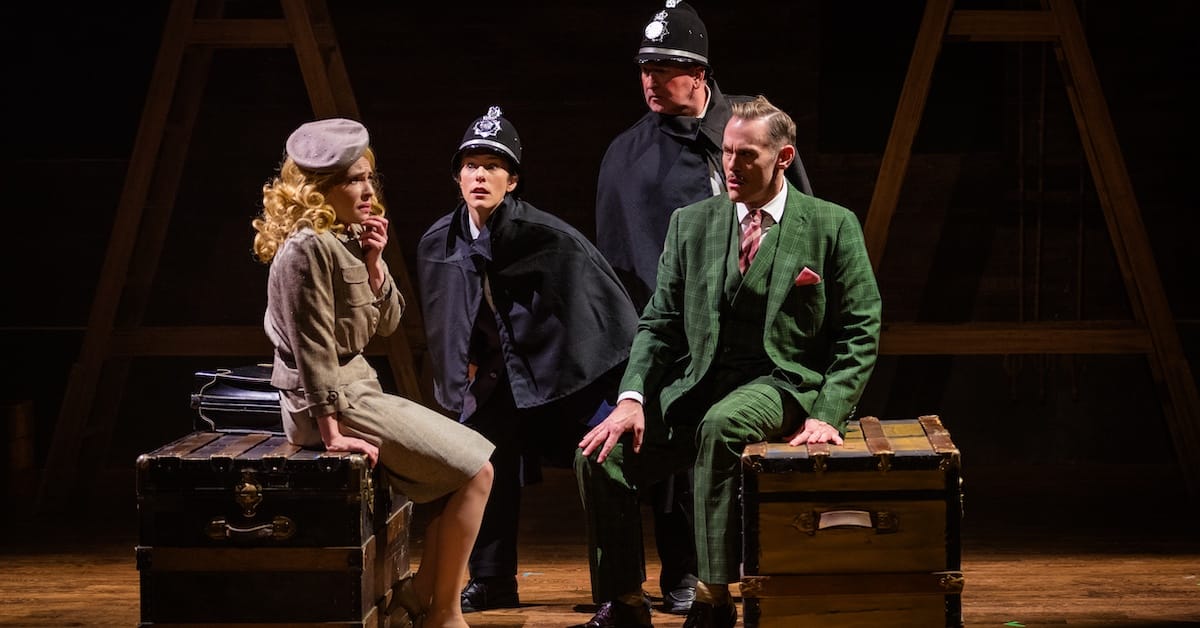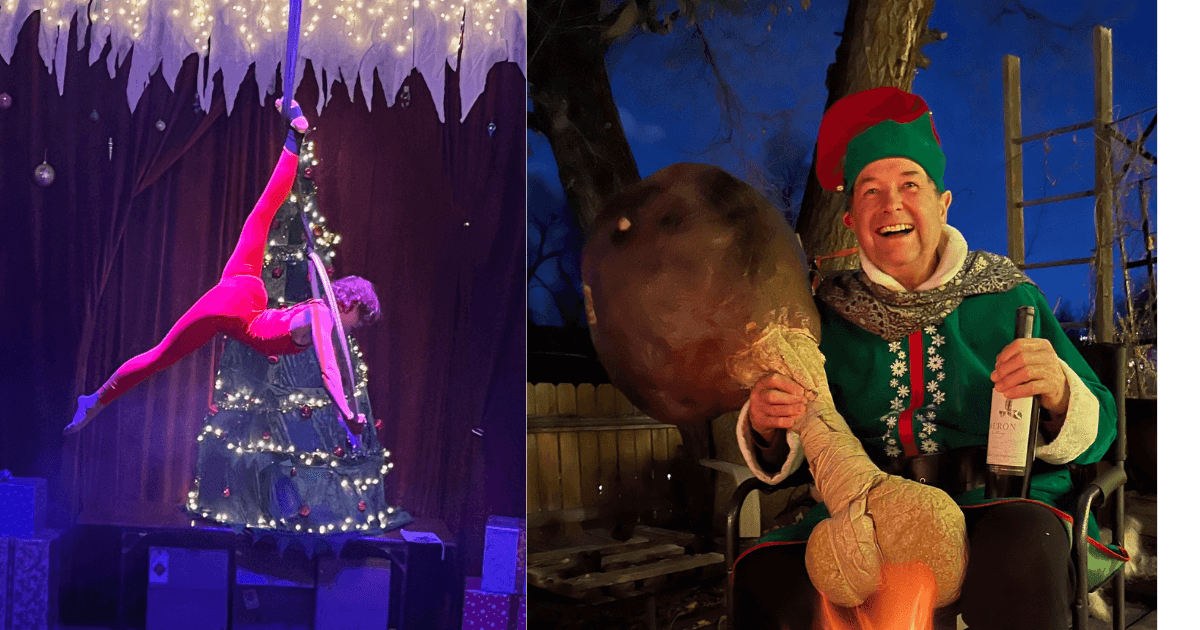In Fort Collins, the Hitchcock parody dishes up a night of high hilarity
The premise behind Patrick Barlow’s parody of Hitchcock’s The 39 Steps is simple, yet audacious: Four actors, armed with little more than basic props, sets and costumes, enact the entire film on stage. Adapting a sprawling spy thriller with a huge cast of characters, high-stakes chase scenes and myriad locations to the theatre is no small feat. Yet, instead of shying away from the challenge, The 39 Steps revels in the absurdity of it, finding humor every step of the way.
The result is a fast-paced romp packed with physical comedy and Pythonesque humor. Whether you’re drawn to the creative possibilities of live theatre or simply in need of a good laugh, OpenStage’s latest production of The 39 Steps, directed by Jessica Jackson, delivers a night of entertainment.
Minimalist set design
With the play’s minimalist approach to such a maximal undertaking, every element — set, props, costumes, lighting, sound and performances — must be thoughtfully executed. Walking into the theatre, you’re greeted by a simple set consisting of a brick wall and two ladders. The backdrop remains unchanged throughout the play, but the quick and clever use of wheeled props, such as doors and furniture, creates the illusion of diverse locations.
The transitions between settings are smooth, effortless and part of the fun. The actors’ playful manipulation of props turns scene changes into jokes themselves, keeping the audience both entertained and impressed.
Costumes also are designed for quick changes, which is essential given that a cast of just four actors portray over 150 roles. Costume Designer Rebecca Evans employs a repertoire of hats, jackets and other accessories to allow for fast and funny transitions between characters.
As Clown 1 and Clown 2, David Austin-Gröen and Heather Ostberg Johnson take on most of the roles, and they execute their breakneck costume changes with sharp comedic timing and playful energy. Meanwhile, protagonist Richard Hannay (Jacob Offen) effuses debonair charm in a 1930s three-piece suit, and actor Katy White embodies Hitchcock’s iconic heroines in period-perfect attire.
The lighting in this production, designed by Matthew Schlief, adds impressive depth and dimension to the minimalist set — unsurprising, given that Schlief also served as the set designer. Each scene is thoughtfully lit to evoke everything from the soft glow of daybreak to the tension of a high-stakes moment, to a sense of physical movement. Schlief’s creative use of color injects the production with an extra layer of campy charm. Speaking of camp, Sound Designer Victoria Villalobos fully embraces the 1930s cinematic spirit with melodramatic orchestral scores that swell between scenes and underscore key dramatic moments.

Photo: Aubrey Renee Photography
Precise performances
Physical comedy is at the heart of The 39 Steps, and the small, energetic cast delivers it with precision. The actors rely on their physicality to bring everything to life, from creating the illusion of a moving train to amplifying emotions and narrative shifts, all with exaggerated but impeccably timed movements. There’s a fluidity to their gestures — nothing feels forced or awkward, which is key for physical comedy to land. Austin-Gröen and Ostberg Johnson make a dynamic duo, and their scenes are some of the show’s most memorable. They seamlessly switch between a variety of different accents, taking full advantage of the many dialects that the UK has to offer. White delivers a hilarious performance as all three of the female leads. From the femme fatale to the country ingénue, to the reluctant lover, she nails the exaggerated, oversexualized archetypes that defined the era.
Expertly synchronized comedy
Of course, the humor in The 39 Steps is very much rooted in a particular brand of British comedy: quirky, satirical and often absurd. If this is your cup of tea, you’ll find no shortage of laughs. However, if you’re not typically drawn to slapstick or Brit wit, there may be moments where the play feels a bit too zany or frenetic. The exaggerated character switches and rapid-fire jokes could certainly become exhausting or repetitive for those who prefer a more grounded or subtle comedic effect.
That said, the show’s craftsmanship is undeniable. If you want to see exactly why The 39 Steps is so effective, just look at the train scene. I won’t spoil it but suffice to say that it’s a high-speed chase brought to life with just a few props, lighting, sound and the sheer talent of its actors. It was simultaneously one of the funniest and most impressive moments I’ve seen in local theatre in years. I couldn’t stop laughing.
In the end, what really sets this play apart is how it lets you in on both the limitations and strengths of live theatre, often in the same breath. With its breakneck pace and slightly manic energy, The 39 Steps may seem chaotic, but this is expertly synchronized comedy. It’s the kind of work where you can’t help but admire the precision behind all the hilarity.
Leila Einhorn lives and writes in Fort Collins. Her poetry, fiction and criticism can be found in various publications both in-print and online, including Always Crashing, Twenty Bellows, Collider and elsewhere. She is a former editorial assistant for the Colorado Review, co-founder of the Philadelphia Free Poetry Workshop in West Philly and a member of the GuloGulo Poetry Collective in Fort Collins. Find her online at www.leilaeinhorn.com.





Leave A Comment